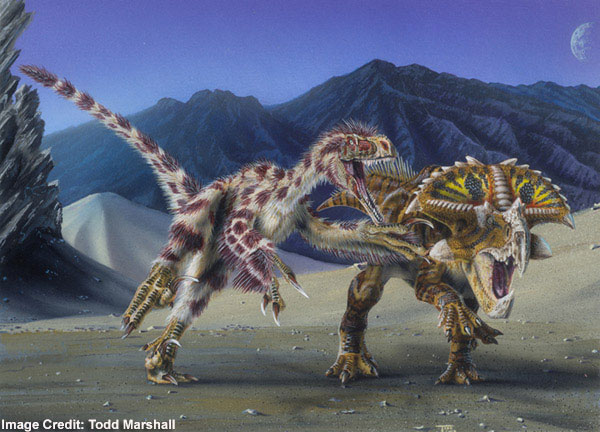Velociraptor Claws Made for Climbing

The vicious Velociraptor of pop culture slashes and disembowels its prey with large, curved claws. The dinosaur gore makes for good cinema, but one research team thinks those claws were made for climbing.
Phillip Manning at the University of Manchester and his colleagues used X-ray scans of fossils from the Late Cretaceous period (spanning from 144 million to 65 million years ago) and drew from knowledge of the material in modern-day owl claws to make a model of the Velociraptor's supposed death sickles.
Velociraptor and other dromaeosaurids were bipedal and lightweight and related to modern birds. A study in 2007 found Velociraptor had feathers, though it could not fly.
Stress tests showed the curved claws "were well-adapted for climbing as they would have been resistant to forces acting in a single (longitudinal) plane, in this case due to gravity," the scientists write in the journal Anatomical Record. "The tip of the claw functioned as the puncturing and gripping element," and the rest of the claw could have transferred the stress to bones.
Previous work by Manning and colleagues, in 2006, used a hydraulic reconstruction of dromaeosaurid limbs to cast doubt on whether the curved claws were effective at disemboweling prey, a long-suspected use for the implements.
The new study found that the claws had a high "failure stress" threshold, "suggesting that Velociraptor would have been able to support its weight on a small contact area while climbing," the researchers write. And it could have perched, much like a modern bird in a tree, they figure.
That doesn't mean Velociraptor wasn't fearsome.
Sign up for the Live Science daily newsletter now
Get the world’s most fascinating discoveries delivered straight to your inbox.
The claws of these extinct creatures could have served to capture prey, too.
"The geometry of dromaeosaur claws would have caused the claw to rotate as it was pushed deeper into prey," the scientists write. A rachet-like ligament would have helped get the claw in deep, they speculate, allowing the dinosaur to use its body weight "to lock the claws passively and allowing the jaws to dispatch the prey."
- Gallery: Dinosaur Drawings
- Avian Ancestors: Dinosaurs That Learned to Fly
- Birds of Prey: Spot Today’s Dinosaurs
Robert is an independent health and science journalist and writer based in Phoenix, Arizona. He is a former editor-in-chief of Live Science with over 20 years of experience as a reporter and editor. He has worked on websites such as Space.com and Tom's Guide, and is a contributor on Medium, covering how we age and how to optimize the mind and body through time. He has a journalism degree from Humboldt State University in California.










